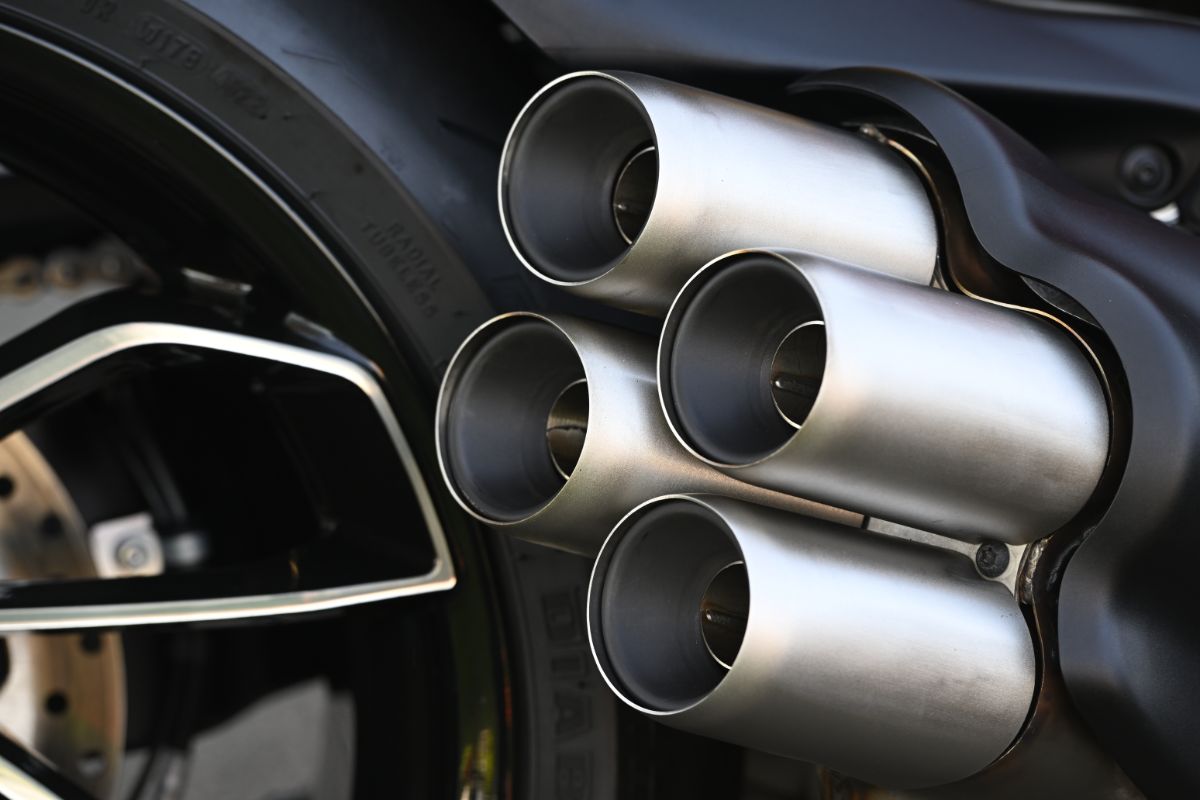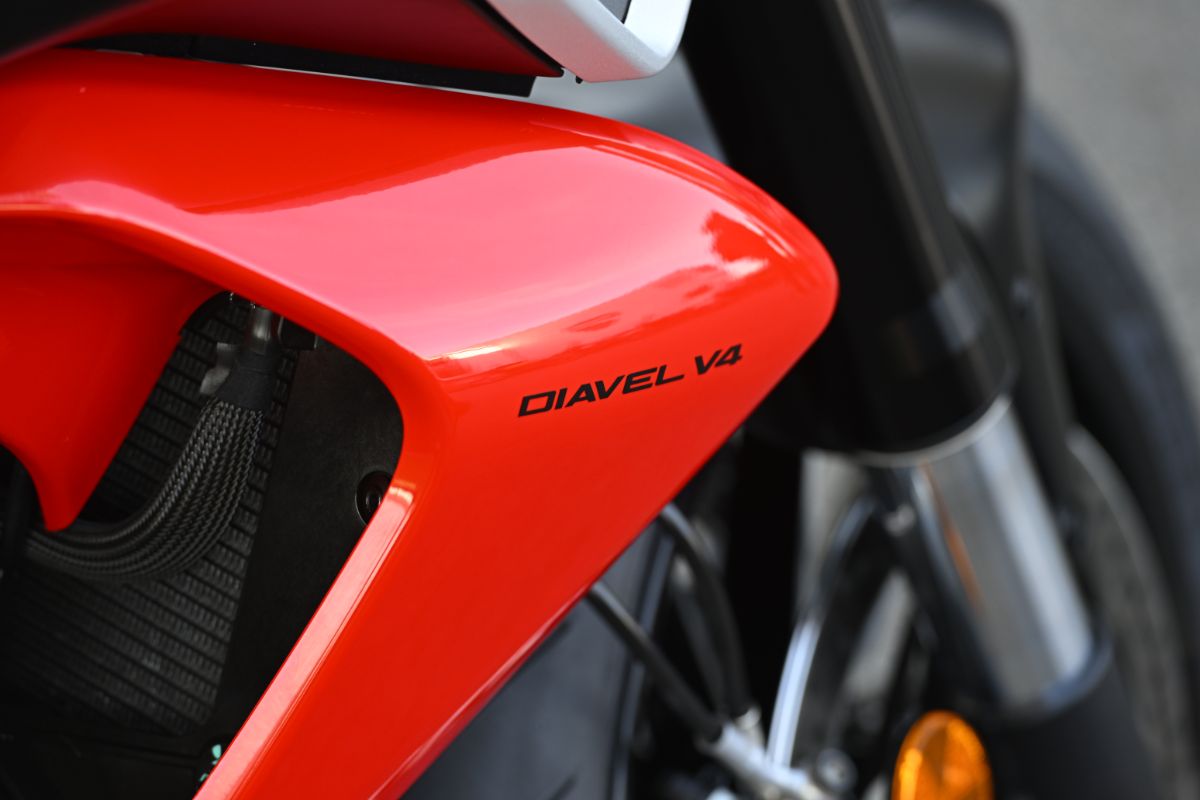The Diavel is a riddle wrapped in a mystery inside an enigma. Looking at what makes the Diavel, a seeming mishmash of components from almost every type of bike you can think of, you’d be excused to think that putting them all in one bike could never work – certainly not anywhere near as well as Ducati had hoped. And yet, that’s exactly what has happened: it works. Really well. Some strong magic must be involved!
Ducati call the Diavel V4 a ‘muscle cruiser’, and as is only natural with muscle bikes, it all starts with the engine. The Diavel is powered by the Granturismo version of Ducati’s big 1158cc V4. The same heart beats in the Multistrada, and a racier version of it, the Desmosedici Stradale V4 runs the Panigale V4 and the Streetfighter V4.

The previous generation Diavel used to have the V2 engine that was a very potent tool too, but times they are a changin’ and the new engine is big, and it’s clever. Not only does it provide more muscles than any cruiser is likely to ask for (168hp and 126Nm to be precise), it also features a counter-rotating crankshaft that works against the gyroscopic forces of the wheels to make the bike more agile and easy to steer. And when you’re at a standstill or pootling about, the engine shuts the rear two cylinders, making it a low rev V twin to stop the engine getting hot and to reduce consumption. Finally, the service intervals are 9000 miles or two years, so the engine doesn’t need that much looking after either.
Chassis-wise, the big change from the previous model is that the tubular steel trellis frame has been binned in favour of an aluminium monocoque design. This is very much the Ducati approach, and the frames that are first designed for racing and sportsbikes then start to appear in the road bikes too. The same thing happened with the new Monster, which caused a bit of a stir, but the feelings about the Diavel’s frame are likely to be less passionate. Either way, the new item is light and strong, and it works.

Suspension is fully adjustable, with the feeling more sporty than touring, although not quite as punishing as the feistier models in the Ducati range. The bike runs pretty low, but there is 120mm travel in the forks and 145mm in the mono-shock at the rear. Given that the units need to control a bike weighing 236kg it makes for a firm but pleasant ride.
Same as Ducati’s other top-level bikes, the brakes are about as good as they get. Brembo Stylema callipers at the front bite into 330mm discs with real purpose, and there is a lovely feel to them.
One thing that hasn’t changed from the previous model is the monstrous 240-section rear tyre. It’s twice as wide as the front. How Ducati has managed to make the bike handle so well with such a massive tyre at the rear is a mystery to me, but that’s exactly what they have done. The bike steers fairly quickly, holds the line well in corners, and feels almost like a ‘normal’ bike. It’s so low with the 790mm seat, and the weight is carried so low, that it’s easy to wheel around, too.

The electronic aids onboard are top-notch. Ride modes, power modes, quickshifter, cornering ABS, traction, launch, wheelie and cruise control are all present and correct. The one that really deserves a special mention out of those is the quickshifter: Ducati has really perfected its quickshifter that works so well in this and the other models too. Gear changes are quick, accurate and smooth, with the feel from the lever not too soft of stiff. It’s quickshifting the way it was meant to be.
Ducati design is particularly strong in the Diavel V4. You just have to admire the folding passenger footpegs, the reshaped tank, and the Gatling gun-like four-pipe exhaust end can. There has clearly been a lot of effort put into making the bike look special, and it does exactly that. It’s not just the bonkers proportions and premium components that make the Diavel, it’s the way that everything has been put together.

If the Diavel has an Achilles heel, it’s the price. At £23,595 it’s an expensive bike, but the customers interested in this kind of bikes are unlikely to be put off by that. The only reasonably direct comparison can be drawn with the Triumph Rocket 3, which is not exactly a budget bike either at £21,995. It seems that if you want to go muscle cruising, you need to be willing to pay for the privilege.
Cost aside, the Diavel is a hugely entertaining bike to ride. Yes, it has its limitations as a tourer with minimal weather protection and luggage options, and yes, it is a bit of a lump of a street fighter, but if you don’t try to compartmentalise it, and just enjoy the ride feel, it’s a thoroughly rewarding bike to ride – and for the sheer head-turning value, it’s priceless.
Ducati Diavel V4 specification
Engine: 1158cc V4
Power: 168hp/124kW @ 10,750rpm
Torque: 126Nm @ 7500rpm
Transmission: Six-speed, chain final drive
Frame: Aluminium monocoque frame
Suspension: 50mm fully-adjustable inverted telescopic forks. Fully-adjustable mono-shock at rear. Single-sided swingarm.
Brakes: Brembo Stylema 4-piston calliper and 330mm semi-floating discs at front. 265mm disc and Brembo 2-piston calliper at rear.
Wheels: 17” front and rear, light alloy cast
Tyres: Pirelli Diablo Rosso III. Front 120/70-17. Rear 240/45-17.
Wheelbase: 1,593mm
Seat height: 790mm
Kerb weight: 236kg (excluding panniers)
Fuel capacity: 20 litres
Contact: www.ducati.com
Words: Mikko Nieminen
Photos: Ducati, Jason Critchell



